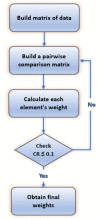An adaptive optimized handover decision model for heterogeneous networks
- PMID: 37967069
- PMCID: PMC10651054
- DOI: 10.1371/journal.pone.0294411
An adaptive optimized handover decision model for heterogeneous networks
Abstract
A heterogeneous network (HetNet), combining different technologies, is considered a promising solution adopted by several upcoming generations of mobile networks to keep up with the rapid development of mobile users' requirements while improving network performance. In this scenario, a vertical handover (VHO) algorithm is responsible for ensuring the continuity of the ongoing user connection while moving within the coverage of the HetNet. Although various VHO algorithms were proposed, achieving efficient performance from both network and user perspectives remains challenging. This paper proposes an adaptive optimized vertical handover algorithm based on a multi-attribute decision-making (MADM) algorithm integrated with particle swarm optimization and gravitational search algorithm (PSOGSA) as a framework to implement the handover process. The algorithm includes three main ideas. Firstly, a network selection framework is proposed considering the most important criteria, including signal strength and other networks' attributes, along with users' characteristics regarding their mobility and service preferences. Secondly, two new parameters are introduced as control handover parameters named load factor (LF) and score priority (SP) to reduce unnecessary handovers and the overall HetNet power consumption while achieving balanced load distribution. Lastly, the desired aims are formulated as an objective function, then the PSOGSA algorithm is used to reach the optimal values of both LF and SP, which will be considered when executing the handover algorithm. The presented algorithm is simulated in a heterogeneous wireless network where the fifth-generation (5G) wireless technology coexists with other radio access networks to improve the evaluation field of the proposed algorithm. Also, the proposed algorithm's performance is evaluated in the case of using various MADM algorithms. The simulation results show that the proposed adaptive optimized approach attains efficient performance by decreasing unnecessary handovers by more than 40% and achieving much better load distribution by around 20% to 40%, outperforming traditional handover approaches.
Copyright: © 2023 Ezz-Eldien et al. This is an open access article distributed under the terms of the Creative Commons Attribution License, which permits unrestricted use, distribution, and reproduction in any medium, provided the original author and source are credited.
Conflict of interest statement
The authors have declared that no competing interests exist.
Figures


























References
-
- Ferdosian N, Berri S, Chorti A. 5G New Radio Resource Allocation Optimization for Heterogeneous Services. In: 2022 International Symposium ELMAR. IEEE, 2022; pp. 1–6.
-
- Nyangaresi V O, Rodrigues A J, Abeka S O. Machine learning protocol for secure 5G handovers. International Journal of Wireless Information Networks. 2022; vol. 29(1); pp. 14–35.
-
- Selim M, Kamal A, Elsayed K, Abd-El-Atty H, Alnuem M. A novel approach for back-haul Self Healing in 4G/5G HetNets. IEEE International Conference on Communications (ICC)2015; pp. 3927–3932.
-
- Patil M B, Patil R. A network controlled vertical handoff mechanism for heterogeneous wireless network using optimized support vector neural network. International Journal of Pervasive Computing and Communications, 2023; vol. 19(1), pp. 23–42.
-
- Nyangaresi V O, Rodrigues A J. Efficient handover protocol for 5G and beyond networks. Computers & Security. 2022; 113, 102546.
MeSH terms
LinkOut - more resources
Full Text Sources

